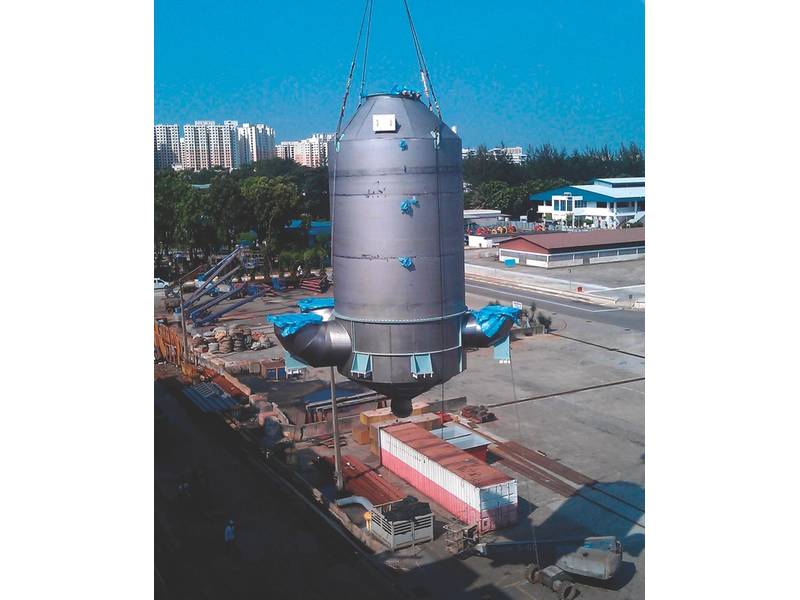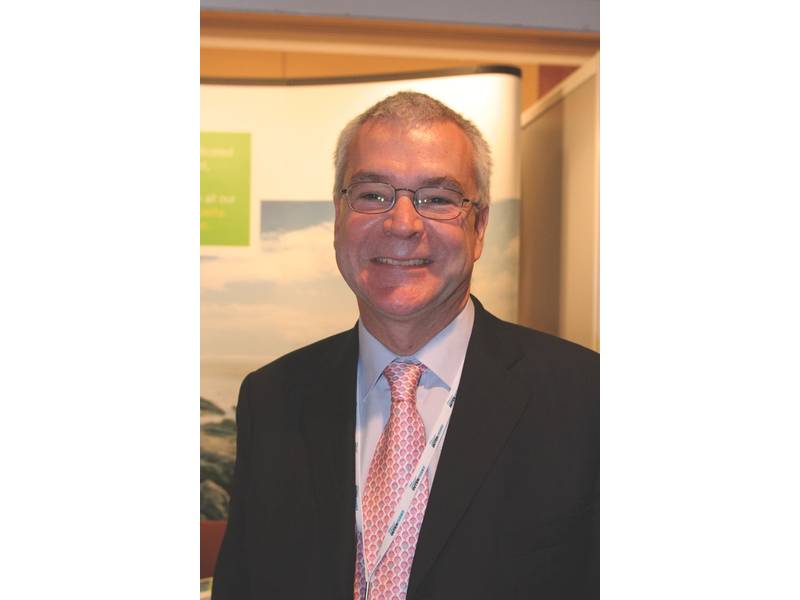New Fuel Regs Drive Scrubber Business
By Tom Mulligan
March 27, 2017
The Exhaust Gas Cleaning Systems Association and its members are preparing to meet higher demand for gas scrubbing systems to bring SOx emissions in line with the targets set by the IMO’s 2020 fuel sulfur content proposals. As previously reported by this correspondent in Maritime Reporter and Engineering News (December 2016 issue, page 24; January 2017 issue, page 28), the IMO has come in for some severe criticism over its proposals to introduce a global marine fuels sulfur content cap of 0.5 percent (mass/mass) by the year 2020. However, the organization can take some encouragement for its ideas from the reactions of the Exhaust Gas Cleaning Systems Association (EGCSA) and major marine scrubbers manufacturers, most of which have expressed their satisfaction with and support for the proposed regulations.
“In October, IMO made the only correct and sensible decision. No delays – from 2020 the global limit on marine fuel sulfur outside of ECAs will be 0.5 percent,” enthused Don Gregory, Director of the EGCSA, while Roger Holm, President of Wärtsilä Marine Solutions, observed that “the introduction of dual-fuel engines and the increasing use of LNG as a fuel will provide a viable means of complying with the sulfur cap requirements.”
A Wärtsilä V-SOx Scrubber being installed on board the MV Tarago. (Photo: Wärtsilä)
Don Gregory, Director, EGCSA: “In October, IMO made the only correct and sensible decision. No delays.” (Photo: EGCSA)
Roger Holm, President, Wärtsilä Marine Solutions: The introduction of dual-fuel engines and the increasing use of LNG as a fuel will provide a viable means of complying with the sulfur cap requirements. (Photo: Wärtsilä)
Gregory went on to say that it was not only for EGCSA members that the proposals bring certainty, but also the whole marine industry and its supplier base. He called it a “definite” decision that was beneficial to human health and the environment, and one that opens the door for businesses to take action.
Start Planning Now
“So, is that job done?” he asked. “Action plans must be put in place now. IMO’s Marine Environment Protection Committee has also tasked its next sub-committee meeting with developing a work plan to ensure a smooth implementation, and the EGCSA and its members are ready and able to take full part in these preparations.
“EGCSA strongly believes that communication, transparency and co-operation between all stakeholders will ease the changeover process. After some 350 ship installations, scrubbing is now well-established and can no longer be considered a new technology. Needless to say, technology and regulatory development is ongoing – in reality it does not stop and there is always a need to build on experience.”
With this in mind, the EGCSA recently hosted a second workshop, in which members, associate members and a number of guests viewed presentations from marine industry stakeholders outside of the Association to provide a platform for discussion on shipowners’ perspectives of scrubbing, scrubbers and the environment, and of the refinery and fuel suppliers’ view of the 2020 proposals.
Future Fuel Prices: The Reality
“With significant overcapacity, low freight rates and poor vessel values, many sectors of the shipping industry have faced a very tough time of late. It is therefore unsurprising that financial uncertainty was one of the themes of discussion,” Gregory stated. “EGCSA’s view is that the future price realities of low-sulfur fuel should not be underestimated and that it is vital that ship operators carefully evaluate all the various payback scenarios when considering how to comply. Although using low-sulfur fuel may seem the obvious choice, it could easily render a vessel uncompetitive at the price differentials expected in 2020 and the easy option may well not be the best.”
Washwater Discharge Quality
Working with Euroshore, the association of European port reception facility providers, the EGCSA has been taking a science-based approach to the quality of scrubber washwater discharges. A new washwater sampling program is currently underway for the European Sustainable Shipping Forum to address the type, source and concentration of material discharged overboard and the results of laboratory analysis are available for both the European Commission and the IMO to view. The EGCSA has said that it was reassuring that if the washwater discharge criteria were to be revised there would be a waiver in the Exhaust Gas Cleaning System Guidelines for those early adopters that have taken part. Within the research program to date, no samples have exceeded the IMO’s limits on polycyclic aromatic hydrocarbons (PAH) – these chemical compounds are an indicator of oil content and analyses have shown that the concentrations of these substances can be up to 30 times less than in water discharges from oil and gas production platforms.
“Knowledge, Not Rhetoric”
The aim of the EGCSA/Euroshore sampling programs is to enable a clear and even application of scrubber discharge rules across Europe and in locations where open and closed loop scrubbers can be used: “Residual fuel and scrubbers can be the most cost-effective and environmentally sustainable method of SOx compliance and EGCSA will use knowledge and data rather than rhetoric to answer questions and explain the benefits,” stated Gregory.
“Scrubbers offer the only alternative to compliance by fuel, not only controlling SOx but also particulate emissions,” he added. “EGCSA members have the capacity and resources to meet demand, market conditions are favorable and we have had the green light from IMO for 2020. It is now investment decision time: this is an opportunity for shipowners.”
Manufacturers Poised for Action
Meanwhile, Wärtsilä Marine Solutions President Roger Holm has said that the company’s proactive development of exhaust gas cleaning systems and broad offering in gas and dual-fuel engine technologies means that the company is in a strong position to help ship owners implement plans for compliance with the new regulations: With its technology certified to IMO gas cleaning systems standards and with the recent approval of its exhaust gas cleaning systems by the Singaporean flag state authorities (an approval recognized across all Asian flag states), Holm said that the introduction of dual-fuel engines and the increasing use of LNG as a fuel will provide a viable means of complying with the sulfur cap requirements.
DuPont has also been quick off the mark in promoting its marine scrubber technology as a viable solution to meet the global sulfur cap:
“Abatement technology such as a DuPont Marine Scrubber is the only way to continue shipping operations as usual with heavy fuel oil of up to 3.5 percent sulfur content while remaining in compliance come 2020,” the company said. “A DuPont Marine Scrubber enables any vessel to meet sulfur emission limits without switching to expensive low-sulfur fuel when entering an ECA.
This economic and highly reliable compliance option allows for ‘business as usual’ bunkering. With a scrubber, there is no need for fuel-switching,” it asserted. “The DuPont Marine Scrubber has ‘run-dry’ capability and no by-pass, allowing vessels that travel in and out of ECAs to comply with regulations: a single scrubber can meet 0.1 percent and 0.5 percent sulfur requirements.”
Compliance and Retrofit: Key Concerns for Shipowners
Technology solutions provider Goltens had this to say on the subject: “The looming deadlines and pending approvals for a variety of environmental emission regulations are making compliance and retrofit a key concern of most shipowners around the globe. In a proactive response to this, Goltens has expanded its competency beyond the ballast water space and made further investments to help shipowners navigate this complex and costly compliance process. Compliance with IMO ECA regulations is becoming a large concern for owners, and, with additional deadlines approaching, for the existing fleet this means retrofit and the consideration of possible compliance solutions ranging from exhaust scrubbers to fuel conversion and boiler retrofit options. Goltens Green Technologies (GGT) is using its proven process to consult and retrofit these technologies with a strong focus on limiting the cost and operational impact on owners.”
One option is to modify vessels to run on emissions-compliant fuel types like LNG or low-sulfur marine gas oil (LSMGO). Goltens said that outside of the LNG fleet, conversion to LNG is rarely cost-effective in a retrofit situation but that conversions to accommodate the use of LSMGO can generally be made with only minor modifications and significantly less capital investment. These options include LSMGO cooler installation and LSMGO fuel conversion for LNG main boilers.
Related News
Liebherr Equips Agogo FPSO with Two Offshore Cranes
Nordic Takes Deliver of MacGregor’s New Electric Heavy Lift Crane
Global Trade War Worries Grow as Trump Unveils Sweeping Tariffs
Worley Secures Work on German LNG Terminal
Metal Shark to Debut High-Speed USV at Sea-Air-Space 2025


